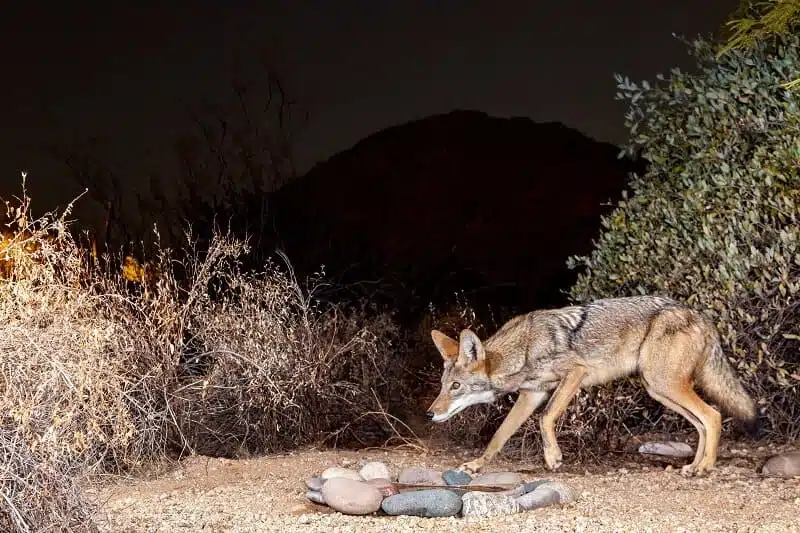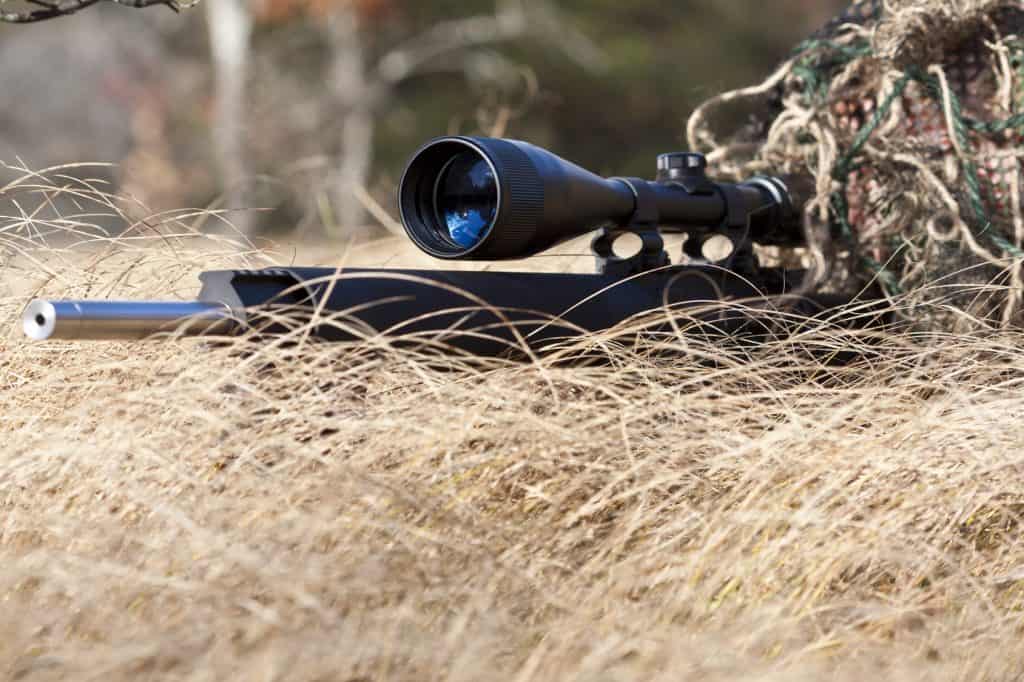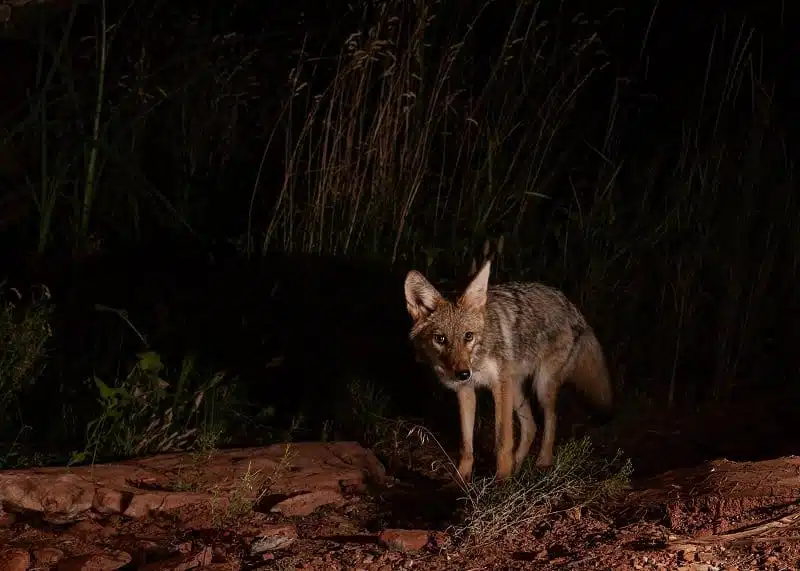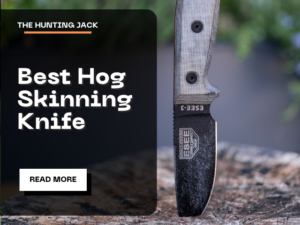Hunting during the night can be challenging, especially if you are dealing with a predator such as a coyote. Still, there are a few things that can play in your favor, assuming you have geared up properly. Knowing the basics of coyote night hunting will give you a definite edge as a hunter and will develop your senses further making day time hunting easier than it was before.
Jack’s Summary:
When out coyote hunting there are a couple of things you have to consider. The first is to choose your spot during the day, as that will allow you to scout the area better. Secondly, you have to use your predator call the right way to lure the coyote closer to you. Once it is close, use your lighting to shine it in its eyes. That will allow you to aim better when taking the shot. The most important thing is to always be patient and quiet.
Head over to my best night vision scopes guide to see some of the top models for this year! Before we dive deeper into the topic, we should ask ourselves a very important question…
Is Night The Best Time To Hunt?
The darker it is the fewer advantages you have, as humans haven’t evolved to thrive in darkness. Still, with the help of proper equipment (discussed below), you can have a definite edge over the coyotes.
Physics and weather conditions are also on your side. Sound waves travel further during the night and there is less wind in most cases. This means that whichever call or howl you use, it will be heard better by the coyotes, ultimately yielding better results. I recommend using your distress sounds from your predator call at a lower volume. Stick to using higher-pitched sounds and emphasize on more frequent howls.
Those tactics will help you determine where the coyotes are but keep in mind that they will come slower at night than they would during the day. They also go downwind (towards the wind) so try to set up a place that is in a similar position compared to the winds.
Overall, you will be very hard to spot during the night, especially if you have a good cover and have blended in well. I prefer shooting standing up from a tripod since I am hard to spot either way.
Now that this is covered, let’s go through some of the major ups and downs of hunting coyotes at night.
Pros & Cons Of Hunting At Night

Advantages
- There is less wind
- You can have a better cover
- Sound travels further
- Thanks to special night hunting equipment you can have a huge edge over the coyotes
Disadvantages
- Requires more preparation
- Very hard to find a good spot if you haven’t done that during the day
- Coyotes are harder to spot even with the right gear
- Some areas and/or states do not allow night hunting
Necessary Gear
The Weapon
Obviously, the most important thing is your weapon of choice. For me, some of the best choices out there are an AR15 and a shotgun. .223 bolt-action rifles are also a great choice if you are into that. I have seen a lot of hunters for a high-end air rifle. Those are usually strong enough for a clean kill at 50-80 yards.
Pro Tip: If you go with a shotgun, opt for a #4 buckshot.
Camouflage
In terms of camouflaging you will need something to really blend you with your surroundings, as coyotes have an excellent sight at any time of the day. Having a good ghillie suit would be ideal for that occasion.
The Predator Call
The electronic call is basically something that allows you to lure predators near you with the sounds of a dying animal. They often have a bunch of sounds pre-loaded in them from which you can choose. Hand calls are also a good addition, depending on your taste and prior experience. If you are new to this, use an electronic one.
Thermal/Night Vision
Having a good night vision scope is one of the most important parts of your gearing-up process and is actually mandatory unless you bring a hunting light. Of course, you can do a combination of both but either one of those two things is an absolute must if you want to have an edge over the coyotes at night.
The ATN X-Sight II HD Smart Night Scope has excellent night vision capabilities making it ideal for such occasions.
Additional Gear
Some of the additional gear that will make things easier for you consists of:
- Shooting tripod
- Decoys
- Additional ammo
- Chair/butt pad
- Mask and gloves
- GPS and scout cameras
Having a tripod is an excellent idea if you like shooting when standing up. Gloves are also something you should always bring along as nights tend to get cold no matter in which state you are.
If you want to check some of the best hunting bipods on today’s market I suggest checking out my detailed guide on the topic. There, I’ve ranked the top models based on their features and have given you a few more tips on how to choose the right one for you.
Night Time Hunting Steps
There are a few things to consider when you are out trying to kill your first coyote during the dark hours of the day. Those are:
- Finding the right spot
- Using your call the right way
- Not rushing things
- Taking advantage of your vision and lighting
- Making the shot
- Taking care of your hunting grounds
Let’s take a look at all of these aspects one by one now, shall we?
Finding the right spot

As funny as it sounds, coyote hunting, especially during the night, is like finding the perfect car/house. It takes a lot of knowledge and searching and basically boils down to your location.
My advice is to always scout during the day, as nighttime pathfinding will only lose you time. If you see a place that is just perfect, ignore it as it has probably been overused by fellow hunters over time. Coyotes are smart and they will avoid such places and move to more secluded regions of your area. It is important to just relax, take your time, and pick a whole day to scout around and find the perfect spot for you which hasn’t been used a hundred times before.
Pro Tip: Coyotes are all about stealth and so should you be. Approach your camping location quietly and maintain this idea throughout the night if you want to be successful in your hunt.
The more you blend in with the environment and the quieter you are the fewer alarms will you raise. Also, a good .308 scope will allow you to be further away from the spot you’re waiting on, so add that to your gear list.
Using your call the right way
When it comes to using your call and howls correctly, there are a lot of steps you need to memorize. Most people overlook this step and therefore fail in their hunting attempts. With coyote hunting, howls and calls are important.
Note: Some specimens will be used to calls due to hunters overusing them, so they will be more hesitant to approach you if you use the typical sounds.
Start off with a few “interrogation” howls. Once you hear any response, howl back in a similar fashion. If you get no response at that time, use a cottontail distress call in the following way:
- Start with a 1-minute call and then do a 15-second pause
- Do another 1-minute call but this time make a 30-second pause
- Make one final 1-minute call and stop
Repeat these steps within a few minutes in-between until you are successful.
If you have spotted a curious coyote that is coming your way I suggest stopping the call. Do some lip-squeaking. That is very effective and in 9 out of 10 cases gets the coyote running towards you.
Coyotes generally appear from a downwind direction, making them sort of predictable but beware as in some (rare) cases they can come from the opposite direction. They also move in circles if they are interested. You can stop them in their tracks when wanting to take a shot by whistling or barking.
Pro Tip: If you encounter two coyotes at the same time, kill one of them immediately. Then use a distress call. That will make the second one look or come back. Once he does that, take the second shot.
Not rushing things
Hunting, in general, takes patience. Hunting at night even more so. Don’t get discouraged if you see nothing in the first 15-30 minutes. You have spent all that time in preparation and have found a great spot, don’t let all that go to waste because there were no coyotes for the first few minutes. Coyote hunting at night hunting is hard, just like hunting in the snow. This is why you need to be persistent and learn not to quit easily.
The thing I see the most when out hunting coyotes is novice hunters packing up after the first half an hour. They think that going to a new spot mid-hunt will change anything. Most often this just gives them away and brings their chances of finding a coyote close to zero.
Taking advantage of your vision and lighting
Using your lights properly will only increase your chances of success. The thing you should be looking for is a glowing pair of eyes. When you spot that, hold the edge of the beam on the eyes so that there is just enough light falling on them. That way they will keep glowing without causing too much distraction. This step is valid for hunting any type of animal during the night. The type of light I prefer for illumination is red light, especially for foggy and moist climates.
Do this until you are ready to shoot. Then, move the beam directly onto the coyote.
Scopes with illuminated reticles are ideal for this scenario. Aim for a 50mm lens.
Making the shot
Once you take the shot, don’t rush to the coyote immediately. Scan the area around you and get a good idea of what is around. The safest way to retrieve the coyote is by having a partner with you.
Depending on the sound of your rifle you will either need to change your position or call it a day (night). If you were too loud, chances are that most coyotes in a mile radius now know that something isn’t right. This is why some hunters prefer air rifles, as they are extremely quiet and powerful enough to do the job.
Taking care of your hunting grounds
Even if you’re hunting and give away your position, chances are that in a few days you will be able to camp at the same spot. That, of course, if not too many hunters use it as well. Make sure that you leave no items behind.
If you want you can mark your way up to that spot by leaving marks on the trees leading to it. Now, let’s go through the things that you will most likely regret doing when you’re hunting at night for coyotes.
What Not To Do
Some of the most common mistakes rookies make are:
- Not hunting in coyote-populated areas
- Using their calls wrongly
- Compromising their position
- Leaving too early
There are many, many more coyote hunting mistakes and that is why I have dedicated a whole article on this topic as it is very crucial to the success of the beginner coyote hunter.
Now, let’s take a look at what are the most common questions people often ask when it comes to this topic.
Frequently Asked Questions
What’s the best time of day to hunt coyotes?
Predators are the most active during the early morning and late evening. These are your two golden windows if you want to make sure that you will spot a coyote. Still, coyotes are active during the night as well, making them an ideal night-hunting target.
What Is The Best Bait For Coyotes?
One of the best baits for coyote hunting at night is definitely a deer carcass. They love anything that has to do with deer meat, so you will really catch their attention with this type of bait.
Where is the best place to shoot a coyote?
For me – it is the heart. In coyotes, the heart sites further in the chest than with most other big game animals. What this means is that you can kill a coyote with a clean shot through either of its front shoulders.
Final Words
Mastering coyote night hunting will greatly add to your hunter’s experience and is also one of the most entertaining hunting options, at least for me. Everything about it, from the scouting earlier that day, to the waiting and using special lights to spot the coyote is just different from any other type of game hunting.



